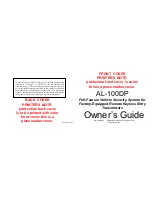
What to do when the Alarm sounds:
(1)
Open the doors and windows to ventilate.
(2)
Turn off the appliance where possible and stop using
the appliance. (The alarm can be silenced immediately by
pushing the test/hush button if the level is below 150ppm
CO).
(3)
Evacuate the property leaving the doors and windows
open.
(4)
Telephone your gas or other fuel supplier on their emer-
gency number; keep the number in a prominent place.
(5)
Do not re-enter the property until the alarm has
stopped. (If the alarm has been silenced by pressing the
test/hush button, wait at least 5 minutes so the alarm can
check that the CO has cleared).
(6)
Get medical help immediately for anyone suffering the
effects of carbon monoxide poisoning (headache, nau-
sea), and advise that carbon monoxide poisoning is sus-
pected.
(7)
Do not use the appliance again until it has been
checked by an expert. In the case of gas appliances this
must be a CORGI registered installer.
When the CO Alarm detects abnormal levels of CO
(above 150ppm CO for 30 minutes) the horn sounds and
the
red light
starts to flash. At higher levels of CO the
alarm will turn on sooner (see table B).
The CO Alarm will automatically reset within about 4
minutes once the CO has cleared. Pressing the test /hush
button resets the CO Alarm immediately if it has sensed
about 150ppm CO (the unit cannot be silenced if the level
is about 350ppm CO). If CO is still present the red alarm
light and horn will turn on again after 4 minutes.
WARNING:
The CO Alarm is no substitute for keeping
chimneys and flues clear and in good condition, and all of
your appliances serviced regularly according to the manu-
facturer’s instructions.
2.1 What is Carbon Monoxide ?
Congratulations on becoming the owner of an Ei Carbon Mon-
oxide Alarm. This will help protect you and your household from
the dangerous effects of carbon monoxide - the silent killer (CO
are the chemical symbols for
C
arbon and
O
xygen).
Many are killed each year, and many more suffer ill health from
carbon monoxide (CO) poisoning. CO is an invisible, odourless,
tasteless and extremely toxic gas. It is produced by appliances
or vehicles burning fuels, such as coal, oil, natural/bottled gas,
paraffin, wood, petrol, diesel, charcoal etc. CO is absorbed by
red blood cells in the lungs in preference to oxygen - this results
in rapid damage to the heart and brain from oxygen starvation.
High levels of CO in a house can be caused by:
l
Incorrectly or poorly installed fuel-burning appliances.
l
Blocked or cracked chimneys/flues.
l
Blocked vents or draught-proofing which makes areas with
fuel burning appliances or fireplaces airtight.
l
Engines of cars, lawnmowers etc. left running in confined
spaces.
l
Portable paraffin or gas heaters in badly ventilated rooms.
2.2 Symptoms of Carbon Monoxide Poisoning
Most people know that high levels of CO are harmful, however
the period of exposure is also important.
The following symptoms are related to carbon monoxide poi-
soning and should be discussed with all members of the house-
hold.
Mild Exposure:
Slight headache, nausea, vomiting, fatigue (of-
ten described as “flu-like” symptoms).
Medium Exposure:
Severe throbbing headache, drowsiness,
confusion, fast heart rate.
Extreme Exposure:
Unconsciousness, convulsions, car-
diorespiratory failure, death.
A high level of CO for a short period (e.g. 350 ppm CO for 30
minutes) will cause the same symptoms, a slight headache, as a
lower level for a longer time (e.g. 150 ppm for 90 minutes). Table
A shows how exposure to different concentrations of CO gener-
ally affects people.
Many cases of reported carbon monoxide poisoning indicate
that while victims are aware they are not well, they become so
disorientated they are unable to save themselves by either leav-
ing the building or calling for assistance. Young children and
household pets may be the first affected.
2.3 What happens when your CO Alarm detects Carbon
Monoxide ?
When the Alarm detects dangerous levels of CO, it sounds a
loud alarm and flashes the red alarm light.
35
The maximum allowable concentration for continu-
ous exposure in any 8-hour period according to
OSHA *.
150
Slight headache after 1½ hours.
200
Slight headache, fatigue, dizziness, nausea after 2-3
hours.
400
Frontal headaches within 1-2 hours, life threatening
after 3 hours, also maximum parts per million in flue
gas (on an air free basis) according to US Environ-
mental Protection Agency.
800
Dizziness, nausea and convulsions within 45 min-
utes. Unconsciousness within 2 hours. Death within
2-3 hours.
1,600
Headache, dizziness and nausea within 20
minutes. Death within 1 hour.
3,200
Headache, dizziness and nausea within 5-10
minutes. Death within 25-30 minutes.
6,400
Headache, dizziness and nausea within 1-2
minutes. Death within 10-15 minutes.
12,800
Death within 1-3 minutes.
* OSHA Occupational Safety &
Health Assocation
s
ppm = parts per million
Table A: Effects of Cumulative CO Exposure
ppm
s
4
2
3
READ THIS FIRST
Carbon Monoxide - The Silent Killer
1.
2.
(Cont.)
!
?
?
CO Level
ppm
Horn on
within
Red
Alarm Light
Status
Stand-by
Off
0
150
Flashes every 2 sec
30 min
Alarm
Alarm
6 min
Flashes every ½ sec
350
Off
Table B: CO Alarm Response
Inhalation Time (approx)
and Symptoms Developed
Concentration of
CO in Air
50
Flashes every 5 sec
Off
Pre-Alarm
4
























